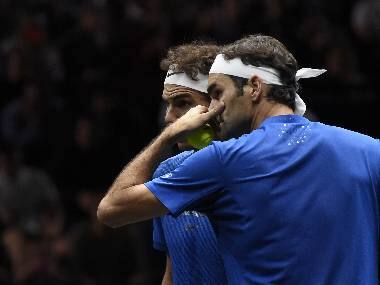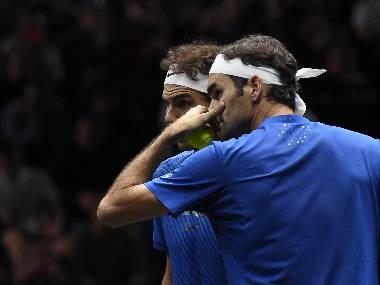Gone are the years, or so it might seem, that a young new teen talent burst upon the tennis ranks to upset the old order, no pun intended. Boris Becker did it in the 1980s and in 2004, a young 17-year-old Spaniard named Rafael Nadal beat the then World No 1 Roger Federer at the Miami Open in straight sets. Nadal would go on to win his first ever Grand Slam at the age of 19. But a look at tennis history reveals that a number of its greats had success in their 30s: Ken Rosewall, considered one of the greatest tennis players in history, won his first ever Open Era Grand Slam aged 33 at the 1968 French Open. Two of the game’s all-time Greats — former No 1s Rod Laver and Arthur Ashe, both won Grand Slam titles in their 30s. [caption id=“attachment_5498001” align=“alignleft” width=“380”] Roger Federer (right) and Rafael Nadal during the Laver Cup last year. AFP[/caption] Today, in 2018, the World No 1 is 32 years old, No 2 is 31 — and on the cusp of regaining his lost crown — and No 3, an anomaly in sport any way you slice it, is 37 years old and showing no signs of stopping. On Friday, the Swiss ace beat World No 10 Kei Nishikori to get one step closer to the title at the Paris Masters. With Federer’s comprehensive win, the cumulative age at the Paris semi-final will be a spry 68 years. The Swiss ace will be hoping for back-to-back titles following his Basel win, but really, the biggest loser against Federer has been time: the Swiss may be 37, but mentally, he has the drive of a 21-year-old raring to prove himself yet again. And in so many ways, he truly has. It is also interesting to note that the top three ranked tennis players of 2018 were also the top three ranked tennis players in 2008, just in a different order. In the past decade, tennis has seen a paradigm shift in the mean age of the Top 10. In October of 2018, the average age of the Top 10 is 29.8 years — almost 30, that average dragged down by the very young (in this context) Alexander Zverev. In 2008, the Top 3 in tennis were the same as they are today — but the average age of the top 10 was 23.9. Interestingly, that would have been lower but for two men — a then 27-year-old Federer, and Czech professional Nikolay Davydenko, also 27.
Roger Federer (right) and Rafael Nadal during the Laver Cup last year. AFP[/caption] Today, in 2018, the World No 1 is 32 years old, No 2 is 31 — and on the cusp of regaining his lost crown — and No 3, an anomaly in sport any way you slice it, is 37 years old and showing no signs of stopping. On Friday, the Swiss ace beat World No 10 Kei Nishikori to get one step closer to the title at the Paris Masters. With Federer’s comprehensive win, the cumulative age at the Paris semi-final will be a spry 68 years. The Swiss ace will be hoping for back-to-back titles following his Basel win, but really, the biggest loser against Federer has been time: the Swiss may be 37, but mentally, he has the drive of a 21-year-old raring to prove himself yet again. And in so many ways, he truly has. It is also interesting to note that the top three ranked tennis players of 2018 were also the top three ranked tennis players in 2008, just in a different order. In the past decade, tennis has seen a paradigm shift in the mean age of the Top 10. In October of 2018, the average age of the Top 10 is 29.8 years — almost 30, that average dragged down by the very young (in this context) Alexander Zverev. In 2008, the Top 3 in tennis were the same as they are today — but the average age of the top 10 was 23.9. Interestingly, that would have been lower but for two men — a then 27-year-old Federer, and Czech professional Nikolay Davydenko, also 27.
A shift, from then to now
Of the current Top 10 men’s tennis players, only three — Alexander Zverev, Grigor Dimitrov and Dominic Thiem are younger than 30, and only Zverev — considered a “future Grand Slam winner” by many on the circuit — is a true outlier. Every other player is 30 years old, or older. The average age of the Top 10 tennis players has been steadily rising, and this year, in 2018, is at the highest it has been in four decades. In 2005, a then-35-year-old American took to the courts at Flushing Meadows towards what would be the end of his professional tennis career, and took a mammoth 25-year-old talent to a tense 6–3, 2–6, 7–6(1), 6–1 final. The older player then was a man most tennis watchers will recognise: Andre Agassi — and his 25-year-old rival was Federer. Then, Agassi set the bar, in a way, for what age meant (or didn’t mean) on the tennis court. Today, it is Federer who is the ‘older gentleman’ on the other side of the net, fulfilling the role Agassi once played opposite him in this Battle of the Ages, as it were. Routinely knocking tweener after tweener, ace after ace, Federer makes it all look effortless, while those half his age, even, look exhausted and appear to be struggling for breath on the other side of the net, only to be sidelined with injuries soon after. Djokovic, who has had his own, quite public struggles with mental and physical health, is now in the shape of his life, as is Nadal. Meanwhile, younger players are being forced to sit out tournaments with consistent struggles; it is to be noted, however, that none are lacking in the talent it takes to reach the top, nor are some of the more talented young players — Thiem and Zverev, for instance — lacking in hard work. However, immense talent is certainly one part of the battle. No amount of talent can save you from the ravages of time and the toll that professional sport can take on a body. But today, fitness and sports science have undergone an incredible transformation. For one, the general awareness around fitness has changed completely. There is no longer any room for speculation around injuries, in large part because medical science has advanced exponentially in the past few years. Increased prize money for victors — and indeed, overall funds in the kitties of various tournaments — has also meant that the top players can afford larger teams, all comprised of the most experienced professionals, to help them stave off injuries before they become major enough to impact careers in the long term. That increasing prize money — with more and more media outlets, sponsors and more, has also meant that players can, quite simply, afford to take time off if they need to. One might argue, then, that the younger crop of higher-ranked players has access to the same pool of medical and sports professionals, the same advancements in medical science, and more. What is then forgotten, as simplistic as this may seem, is the maturity and understanding of the game — and their bodies, that older players possess. The biggest advantages a younger player might have over an older one are stamina and physicality. Once those are taken away, given today’s fitness techniques as well as strategic play by older players, it becomes, then, a game of nuanced technique, a game of mentality, and a game of experience — putting, to borrow a popular turn of phrase, the ball in the older player’s court. With age comes experience, an adage that holds true even in sport. At 37, Federer is able to schedule his tournaments better to maximise his points and minimise the toll on his body. A younger player might take their body for granted, as so many do, and pack a season full of tournaments, which eventually impacts their bodies — and in the long run — their careers, poorly. In fact, such was the case with Thiem, who in 2015 and 2016 was called out on not scheduling his tournaments effectively — something that seriously impacted the young ace’s results at the time. Older players, by virtue of not just being older, but having the experience that they do, are less likely to buckle — or panic — under pressure. Apart from a few young players at the top, many of the ATP’s Next Gen talents are struggling with the pressure to perform. In contrast, the ‘older generation’ possesses the maturity and security that come with age, experience and most importantly, overall stability — something that is absent in the early parts of the careers of many players, if not most. In 2018, every male Grand Slam winner has been older than 30 — and barring Thiem, who lost to Nadal at the French Open — every single Grand Slam finalist in 2018 has been over 30. This is not to say there is a lack of talent in the younger tennis field: in fact, many of its biggest talents are only just beginning to rise through the ranks — Alex de Minaur and Stefanos Tsitsipas among them. It is then a question of sustainability, stamina, time management and that demon so many see every day, in sport or otherwise: self-belief. It also helps, perhaps, if like the Top 3 today (and in 2008), if you have been bestowed, deservingly, the title of Greatest of All Time.
)